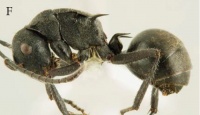Polyrhachis tanami
| Polyrhachis tanami | |
|---|---|

| |
| Scientific classification | |
| Kingdom: | Animalia |
| Phylum: | Arthropoda |
| Class: | Insecta |
| Order: | Hymenoptera |
| Family: | Formicidae |
| Subfamily: | Formicinae |
| Tribe: | Camponotini |
| Genus: | Polyrhachis |
| Subgenus: | Hagiomyrma |
| Species group: | penelope |
| Species: | P. tanami |
| Binomial name | |
| Polyrhachis tanami Kohout, 2013 | |
Polyrhachis tanami is known only from a single locality in the Tanami Desert and nothing is known of its nesting habits.
Identification
A member of the penelope species-group in the Polyrhachis subgenus Hagiomyrma. Kohout (2013) - Polyrhachis tanami is characterised by its small size and distinctly and rather deeply sculptured body. It is relatively similar to Polyrhachis tenebra, with which it shares rather strongly posteriorly converging margins of the promesonotal dorsum (PMI 176-177 in P. tanami versus 172 in P. tenebra) and virtually identically shaped petiolar spines. However, P. tenebra has the dorsum of the head and mesosoma more finely reticulate-punctate with the sculpture on the anterior pronotum, including the humeri, and most of mesonotum and propodeum partially hidden by relatively long, appressed, pale golden pubescence.
Keys including this Species
Distribution
Latitudinal Distribution Pattern
Latitudinal Range: -19.05° to -19.05°.
| North Temperate |
North Subtropical |
Tropical | South Subtropical |
South Temperate |
- Source: AntMaps
Distribution based on Regional Taxon Lists
Australasian Region: Australia (type locality).
Distribution based on AntMaps
Distribution based on AntWeb specimens
Check data from AntWeb
Countries Occupied
| Number of countries occupied by this species based on AntWiki Regional Taxon Lists. In general, fewer countries occupied indicates a narrower range, while more countries indicates a more widespread species. |

|
Estimated Abundance
| Relative abundance based on number of AntMaps records per species (this species within the purple bar). Fewer records (to the left) indicates a less abundant/encountered species while more records (to the right) indicates more abundant/encountered species. |

|
Biology
Castes
Known only from the worker caste.
Nomenclature
The following information is derived from Barry Bolton's Online Catalogue of the Ants of the World.
- tanami. Polyrhachis (Hagiomyrma) tanami Kohout, 2013: 549, figs. 9E-F (w.) AUSTRALIA.
Unless otherwise noted the text for the remainder of this section is reported from the publication that includes the original description.
Description
Worker
(holotype cited first): TL c. 6.10, 6.65; HL 1.59, 1.59; HW 1.22, 1.28; CI 77, 80; SL 1.87, 1.87; SI 153, 146; PW 1.15, 1.18; MW 0.65, 0.67; PMI 177, 176; MTL 2.03, 2.09 (2 measured).
Anterior clypeal margin with shallow, denticulate, median flange. Clypeus with distinct median carina; almost straight in profile, posteriorly rounding into shallowly impressed basal margin. Frontal carinae sinuate, with only weakly and narrowly raised margins. Sides of head converging towards mandibular bases in virtually straight line; behind eyes, sides rounding into convex occipital margin. Eyes convex, in full face view clearly exceeding lateral cephalic outline. Ocelli lacking. Pronotal humeri rounded with narrowly raised margins; lateral margins converging towards well impressed promesonotal suture. Mesonotum with margins converging towards poorly indicated metanotal groove. Propodeal dorsum armed with slender, horizontal, divergent spines, weakly curved outwards and downwards from midlength. Petiolar spines widely divergent, raised obliquely from bases, continued horizontally towards weakly upturned tips. Anterior face of first gastral tergite widely rounding onto dorsum.
Mandibles very finely, closely, longitudinally striate with piliferous pits. Head, mesosoma and petiole very distinctly, rather coarsely reticulate-punctate; sculpturation on vertex distinctly, mostly longitudinally striate. Sculpturation less coarse on dorsum of mesosoma, pronotal sculpture consisting of somewhat irregular, anteriorly converging, rather flat striae. Gaster shagreened; sculpturation on dorsum more distinct with numerous shallow pits.
Mandibular masticatory and outer borders with numerous, curved, golden hairs, hairs suberect towards bases. Anterior clypeal margin with a few longer setae medially and fringe of shorter setae laterally. Most body surfaces, including appendages, with numerous, short to medium length, mostly erect hairs; gaster with hairs marginally longer and more posteriorly directed. Very diluted short, silvery, closely appressed pubescence on head, mesosoma and petiole; pubsecence somewhat more abundant and golden on dorsum of gaster.
Black; mandibles reddish-brown. Appendages black or very dark reddish-brown.
Type Material
- Holotype, worker, Central Tanami Desert, 152 km E of Lajamanu, Northern Territory, Australia, 19°3′0″S 131°51′0″E / 19.05°S 131.85°E, 26.vii.2001, A.L. Hertog, Australian National Insect Collection.
- Paratype, 1 worker, Central Tanami Desert, 152 km E of Lajamanu, Northern Territory, Australia, 19°3′0″S 131°51′0″E / 19.05°S 131.85°E, 26.vii.2001, A.L. Hertog, Queensland Museum.
Etymology
From the type locality, the Tanami Desert in the Northern Territory.
References
- Heterick, B.E. 2021. A guide to the ants of Western Australia. Part I: Systematics. Records of the Western Australian Museum, Supplement 86, 1-245 (doi:10.18195/issn.0313-122x.86.2021.001-245).
- Heterick, B.E. 2022. A guide to the ants of Western Australia. Part II: Distribution and biology. Records of the Western Australian Museum, supplement 86: 247-510 (doi:10.18195/issn.0313-122x.86.2022.247-510).
- Kohout, R. J. 2013c. Revision of Polyrhachis (Hagiomyrma) Wheeler, 1911 (Insecta: Hymenoptera: Formicidae: Formicinae). Memoirs of the Queensland Museum - Nature 56:487-577.
